Beneath the world’s oceans lies a vast realm teeming with extraordinary biodiversity. Encompassing over 230,000 known species, with potentially millions more yet to be discovered, these underwater ecosystems are marvels of nature that play an essential role in marine ecosystem health. From the smallest plankton to the largest whales, marine organisms contribute to critical functions such as oxygen production and climate regulation. This rich tapestry of ocean life, including vital habitats like coral reefs, is foundational for sustaining planetary health.
Key Takeaways
- Oceans are home to over 230,000 known species, with countless more undiscovered.
- Underwater ecosystems contribute vital ecological services, including oxygen production.
- Marine biodiversity is crucial for climate regulation and maintaining marine ecosystem health.
- Coral reefs are among the most significant habitats within ocean life.
- Preserving marine organisms is essential for sustaining planetary health.
The Essence of Marine Biodiversity
Marine biodiversity encompasses the vast variety of life within oceanic ecosystems, contributing significantly to the planet’s overall ecological health. This diversity includes a range of organisms, from microscopic plankton to colossal apex predators, each playing a vital role in maintaining marine life importance.
Definition and Importance
Understanding the biodiversity definition within marine environments is crucial, as these ecosystems offer essential ecosystem services such as nutrient cycling, climate regulation, and maintaining water quality. The intricate relationships between different marine species ensure the stability and productivity of the ocean. Without this biodiversity, the ocean’s ability to support human life and thriving marine life would be severely compromised.
Statistics and Scope
The biodiversity statistics of our oceans highlight the immense scope of marine life. Constituting about 71% of Earth’s surface, the oceans are home to approximately 228,450 known marine species, with numerous more yet to be identified. This sheer volume underscores the critical need for comprehensive studies and conservation efforts.
Take a look at some key statistics that emphasize the importance and extent of marine biodiversity:
| Aspect | Statistics |
|---|---|
| Percentage of Earth’s Surface | 71% |
| Known Marine Species | 228,450 |
| Unknown Marine Species | Potentially Millions |
Unique Habitats: Coral Reefs, Mangroves, and Deep-Sea Vents
Marine habitats are a mosaic of extraordinary ecosystems, each offering their own unique contributions to ocean biodiversity. Delving into coral reefs, mangrove ecosystems, and deep-sea vents reveals the incredible variety and resilience of ocean life.
Coral Reefs
Coral reefs are renowned for their stunning biodiversity. These underwater structures support numerous marine species, making them invaluable to global coral reef diversity. Spanning tropical to subtropical waters, reefs act as breeding grounds, feeding areas, and shelters for marine life.
The intricate formations of coral reefs provide habitat for fish, crustaceans, mollusks, and countless other species. Protecting these marine habitats is vital, as they are among the most valuable and at-risk ecosystems on Earth.
Mangroves
Mangrove ecosystems offer critical coastal protection and environmental benefits. Found in tropical and subtropical regions, mangroves serve as oxygen-producing nurseries for various marine species. Their dense root systems provide shelter and breeding grounds, supporting the life cycles of fish, shrimp, and other marine organisms.
In addition to their biological importance, mangroves play a significant role in coastal defense, mitigating the impact of storms and erosion. The health of mangrove ecosystems directly affects the wellbeing of coral reefs and other marine habitats they support.
The Role of Marine Species in Ecosystem Health
The intricate balance of marine ecosystems requires a variety of species, each playing a crucial role. This section delves into the functions of apex predators and primary producers in maintaining marine ecosystem balance.
Apex Predators
Predators at the top of the food chain, like sharks and large fish, are pivotal for managing prey populations, directly influencing the marine ecosystem balance. The apex predator role affects species diversity and abundance, shaping the entire food web. Without these crucial players, prey species could proliferate unchecked, leading to the degradation of marine habitats.
Primary Producers
Primary producers, including phytoplankton and seagrasses, form the foundation of marine food webs. They perform critical processes like carbon sequestration, converting carbon dioxide into organic matter. The phytoplankton importance can’t be overstated as they generate a considerable portion of the world’s oxygen while forming a fundamental base for the marine food chain.
| Role | Example | Key Function |
|---|---|---|
| Apex Predators | Sharks | Maintain prey population |
| Primary Producers | Phytoplankton | Carbon sequestration |
Marine Mammals: Guardians of the Seas
Marine mammals, including whales and dolphins, are vital for maintaining marine biodiversity. Acting as ocean guardians, they help regulate prey populations and contribute significantly to the health of ecosystems.
Whales and Dolphins
Whales and dolphins exemplify the vast *cetacean diversity* present in our oceans. These magnificent creatures impact their environment in numerous ways, from modulating prey populations to facilitating nutrient distribution. Their presence is crucial for marine mammal conservation efforts, as they serve as indicators of ocean health, reflecting the broader state of marine ecosystems.
Marine Mammals and Ecosystems
Marine mammals act as key *ecosystem regulators*, ensuring the balance and productivity of marine environments. They play significant roles by participating in nutrient cycling, transferring nutrients from the deep ocean to surface waters. The impact of marine mammals extends beyond maintaining biodiversity; their existence is essential for stabilizing food webs and fostering richer, healthier ocean ecosystems.
The roles of marine mammals are diverse and intricate. They contribute to the broader marine ecosystem through:
- Prey population control
- Nutrient distribution
- Indicators of ocean health
By supporting marine mammal conservation, communities and organizations contribute to the overall well-being of marine ecosystems. Efforts to protect these creatures are vital for sustaining the intricate balance of ocean life and advocating for a healthier planet.
Algal Blooms: Indicators of Ocean Health
Algal blooms serve as crucial ocean health indicators, reflecting shifts in marine ecosystems. These blooms, often amplified by nutrient runoff and climate change, play a significant role in evaluating the overall state of our oceans.
Causes and Effects
Algal blooms often originate from the excessive introduction of nutrients into marine ecosystems. This nutrient runoff typically includes nitrogen and phosphorus, which are common by-products of agricultural activities and urban runoff.
- Nutrient Runoff: Excessive nutrients from fertilizers entering water bodies.
- Climate Change: Rising temperatures promoting algal growth.
The impacts of algal blooms can be profound and far-reaching:
- Hypoxia: Reduced oxygen levels in water, leading to dead zones.
- Marine Life Impact: Harmful algal blooms releasing toxins, affecting fish and other marine organisms.
Algal Blooms and Marine Life
The correlation between algal blooms and marine life impact underscores the critical nature of monitoring these ocean health indicators. Algal bloom impacts can include producing harmful toxins that devastate marine life and ecosystems. This phenomenon can lead to hypoxic conditions, severely disrupting the balance of marine ecosystems and resulting in widespread marine life impact.
| Aspect | Impact on Marine Life |
|---|---|
| Hypoxia | Reduction in species due to lack of oxygen |
| Toxins | Harm to fish, shellfish, and marine mammals |
| Ecosystem Balance | Disruption of food chains and habitats |
Marine Protected Areas: Preserving Biodiversity
Marine Protected Areas (MPAs) play a pivotal role in the preservation of marine biodiversity. These protected marine zones offer a refuge for species recovery, safeguarding against overfishing and habitat destruction.
Importance of MPAs
The benefits of MPAs extend far beyond conserving marine life. By designating specific regions as protected marine zones, ecosystems are given the chance to rejuvenate. This fosters biodiversity preservation, ensuring that delicate marine habitats remain undisturbed. Additionally, MPAs help to maintain genetic diversity which is critical for the resilience of aquatic communities.
Current Initiatives
Current conservation initiatives worldwide emphasize the expansion and enforcement of MPAs. Efforts are being made to increase the number of protected marine zones to cover a more significant portion of the ocean, reinforcing biodiversity preservation. International collaborations and local conservation programs work hand in hand to implement these initiatives, highlighting the MPAs benefits on a global scale. By prioritizing these conservation initiatives, we can look forward to a future where our oceans thrive once more.
| Initiative | Region | Objective |
|---|---|---|
| Global Ocean Alliance | International | Expand MPAs to 30% by 2030 |
| Pacific Remote Islands Marine National Monument | United States | Protecting coral reefs and marine ecosystems |
| Wakatobi National Park | Indonesia | Sustainable tourism and marine biodiversity |
Threats to Marine Biodiversity
Marine biodiversity is under increasing pressure from various human activities and environmental changes. These threats impact the delicate balance of marine ecosystems, affecting both the organisms within them and the services these ecosystems provide. Understanding the primary threats to marine life is crucial for developing effective conservation strategies.
Pollution
Ocean pollution is one of the most severe threats to marine biodiversity. Contaminants such as plastic debris, chemical runoff, and oil spills disrupt habitats and endanger marine species. Toxins can accumulate in the food web, causing long-term health issues for marine life and even affecting human consumers. Efforts to mitigate pollution involve reducing waste, improving waste management practices, and enforcing stricter regulations to control pollutant discharge into marine environments.
Overfishing
Unsustainable fishing practices pose another significant threat to marine biodiversity. Overfishing depletes fish populations, disrupts food webs, and deteriorates habitats. The removal of key species can lead to changes in the structure and function of marine ecosystems, making them less resilient to other stressors. Sustainable fishing practices and effective management of fisheries are essential to protect marine resources and ensure their longevity for future generations.
Climate Change
Climate-related changes, such as global warming and ocean acidification, have profound effects on marine life. Rising sea temperatures can cause coral bleaching and the loss of critical habitats, while acidification affects the ability of marine organisms to build shells and skeletons. These changes alter the distribution and abundance of marine species, leading to shifts in ecosystem dynamics. Tackling climate change through global cooperation and reducing carbon emissions is critical to preserving marine biodiversity.
Efforts in Coral Reef Conservation
Coral reef conservation is imperative to maintain marine biodiversity and ecosystem services. Various conservation strategies have been designed to address the numerous threats that coral reefs face. One of the essential methods is coral reef restoration, an active approach that involves rehabilitating degraded reef areas to enhance reef resilience.
Several core strategies underpin the efforts in coral reef conservation:
- Habitat Protection: Establishing marine protected areas (MPAs) provides safe zones where human activities are regulated to minimize damage.
- Pollution Reduction: Implementing measures to reduce industrial runoff and plastic waste helps to lower local stressors on coral ecosystems.
- Active Restoration Techniques: Techniques such as coral gardening involve cultivating and transplanting healthy corals to damaged areas to promote recovery and ensure biodiversity enhancement.
Combining these conservation strategies is vital for the survival and health of coral reefs. Ongoing efforts not only focus on reef protection but also aim at fostering sustainable interactions between human activity and marine environments.
Effective coral reef conservation calls for a global commitment to sustain the natural beauty and function of these critical ecosystems. Long-term success in these initiatives promises a stable increase in biodiversity enhancement and robust reef protection for future generations.
The Impact of Climate Change on Marine Biodiversity
Climate change is having profound impacts on marine biodiversity, affecting the intricate balance of ocean ecosystems. Two critical issues—ocean acidification and coral bleaching—illustrate the extensive climate effects on oceans, which threaten coral health and overall climate resilience.

Ocean Acidification
Ocean acidification is a significant consequence of increased atmospheric CO2. This process alters the pH balance of seawater, making it more acidic. The resulting change hampers the ability of calcifying organisms, such as mollusks and some plankton species, to form their protective shells. This issue directly impacts marine food webs and reduces biodiversity, highlighting the urgent need for enhanced climate resilience measures to combat these climate effects on oceans.
Coral Bleaching
Coral bleaching is another devastating impact of rising ocean temperatures. Warmer waters cause corals to expel symbiotic algae, leading to loss of color and vital energy sources. Prolonged bleaching events can result in mass mortality of reef systems, severely affecting coral health and decreasing habitat availability for diverse marine species. These events underscore the necessity for international initiatives focused on improving climate resilience and mitigating the adverse climate effects on oceans.
| Key Issue | Impact on Marine Biodiversity | Need for Action |
|---|---|---|
| Ocean Acidification | Reduced ability for organisms to form shells; disrupted food webs | Increase climate resilience efforts |
| Coral Bleaching | Coral mortality; decreased habitat for marine species | Mitigate rising ocean temperatures |
Conservation and Restoration Initiatives
Conservation and restoration initiatives play a critical role in mitigating threats to marine biodiversity. Through habitat restoration, sustainable resource management, and advancing scientific research, these efforts focus on securing a future for our oceans’ health and productivity.
One of the primary approaches to fostering marine species recovery is the implementation of biodiversity initiatives. These initiatives aim to protect and rehabilitate key marine environments by addressing threats such as pollution, overfishing, and climate change. By restoring the natural balance within these ecosystems, marine life can thrive.
Sustainable practices are at the core of these conservation efforts. Practices such as regulated fishing, marine protected areas (MPAs), and pollution control measures help maintain the delicate balance of the ocean’s resources. Additionally, community involvement and education play essential roles in promoting sustainable behaviors and ensuring long-term success.
The following table highlights some of the significant conservation and restoration efforts worldwide:
| Initiative | Region | Focus | Outcome |
|---|---|---|---|
| Great Barrier Reef Rebuilding | Australia | Coral Restoration | Increased coral cover and marine species recovery |
| Marine Life Protection Act | California, USA | Establishment of MPAs | Protection of biodiverse regions, sustainable practices |
| Blue Belt Program | UK Overseas Territories | Research and Policy Implementation | Enhanced habitat restoration and marine species recovery |
In conclusion, conservation and restoration initiatives ensure the resilience of marine ecosystems. By integrating sustainable practices and innovative strategies, these efforts are paving the way for a healthier and more sustainable ocean environment.
Conclusion
The vitality of our planet is intrinsically linked to the health of marine ecosystems, which harbor an extraordinary diversity of life forms. Successful marine ecosystem preservation hinges on implementing sustainable practices, enacting robust policies, and fostering global collaborative conservation efforts. Through biodiversity stewardship, we can create resilient marine environments that withstand various anthropogenic pressures.
Our investigation into the multifaceted aspects of marine life — from the critical role of coral reefs and apex predators to the importance of mitigating threats such as pollution and climate change — underscores the need for heightened ecological responsibility. Each section of this article has articulated the intricacies involved in safeguarding marine biodiversity, illustrating that a multifaceted approach is essential.
As global citizens, our actions collectively shape the sustainable future of our planet’s oceans. By prioritizing marine ecosystem preservation, advocating for biodiversity stewardship, and embracing our ecological responsibility, we pave the way for a thriving marine environment. Let us strive to maintain the delicate balance that allows the symphony of ocean life to continue its harmonious existence and ensure a sustainable future for generations to come.











